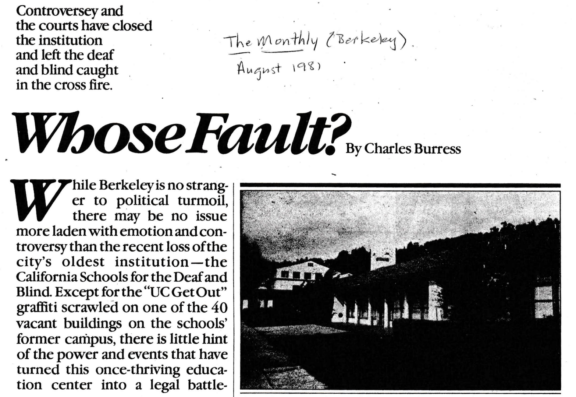A report on the earthquake faults below the Deaf-Blind school sites, and the buildings on the site that would need to be retrofitted in order to meet the state standards for educational institutions on “active” quake sites. After the site was deemed seismically unsafe, the city of Berkeley and the University clash over the future possibilities of the 50-acre site. On one hand, the University wants to expand their student housing, and the other hand the city sees an opportunity to build low-income housing for the elderly and disabled.

Aside from the land, architecturally the Deaf and Blind school site is home to mission style architecture with red tiled roofs. Historically, the site is one of the largest parcel of property under single ownership in Berkeley that was created 11 years before Berkeley was officially a city and 6 years prior to the establishment of the University. 
Although the Deaf community initiated S.O.S (Save Our School), by raising funds to rebuild a structurally safe school, the fear of mainstreaming Deaf education into hearing education, changes the financial focus from saving the site, to creating a new site.
Although the Deaf community accepts their new home in Fremont, the Blind community soldier on with hopes to remain in their over 100 year old site.
Unfortunately the architectural structures are used against the disabled community. The old two story buildings and steep terrain pose an unsafe environment for a growing student population with multiple disabilities.
 On August 5, 1980, as the schools are set to open in Fremont, the U.S. District Court Judge Milton Schwanz halt the move. Unfortunately the state refuses to provide funds to maintain the Berkeley site for another year, resulting in another push toward moving the site toward Fremont.
On August 5, 1980, as the schools are set to open in Fremont, the U.S. District Court Judge Milton Schwanz halt the move. Unfortunately the state refuses to provide funds to maintain the Berkeley site for another year, resulting in another push toward moving the site toward Fremont.
Infamous teacher and advocate for the Berkeley site, John Di Francesco retired from teaching for the Blind school, yet continued the fight against the move, which ultimately deemed unsuccessful.
